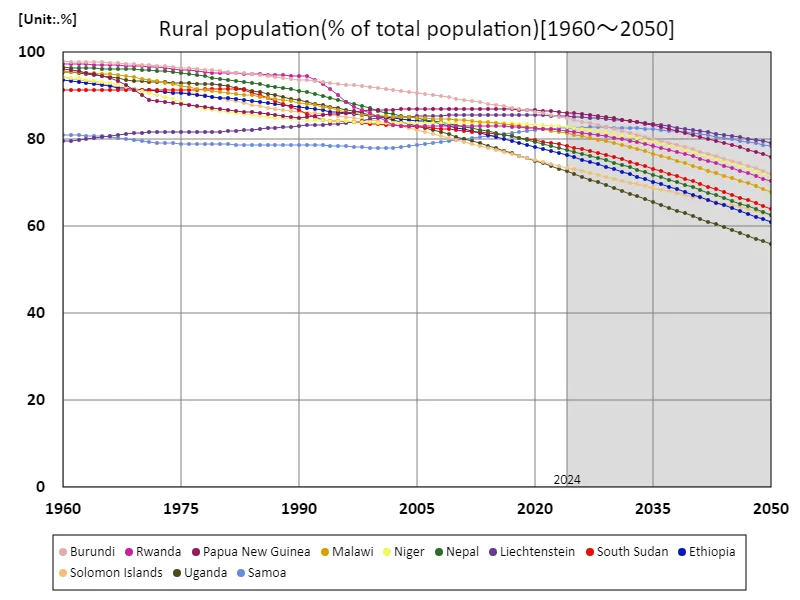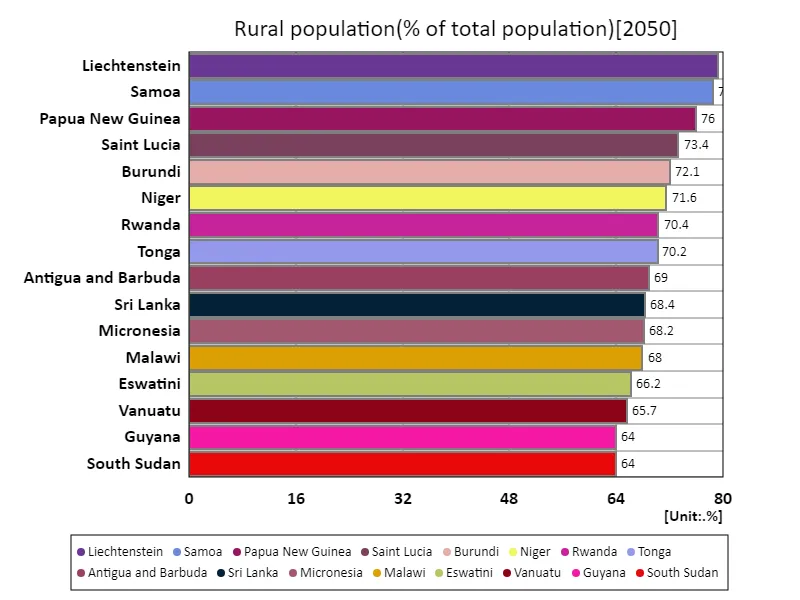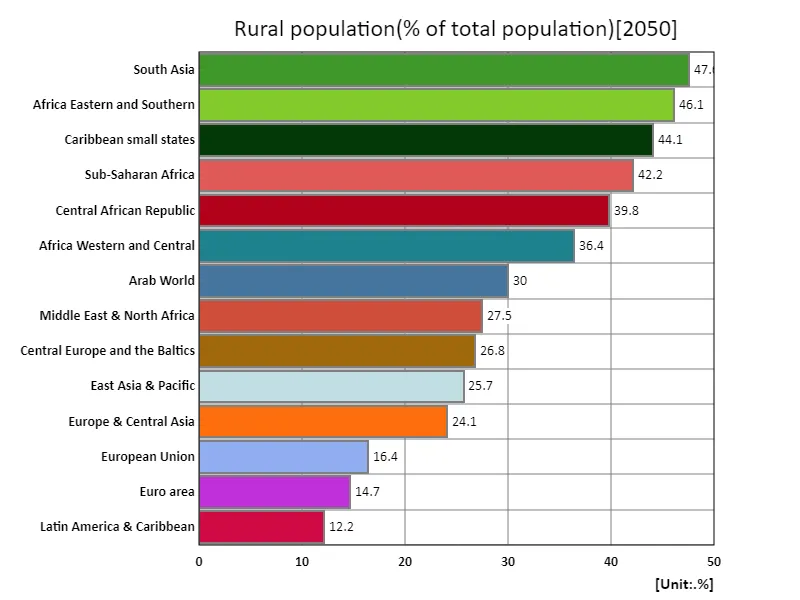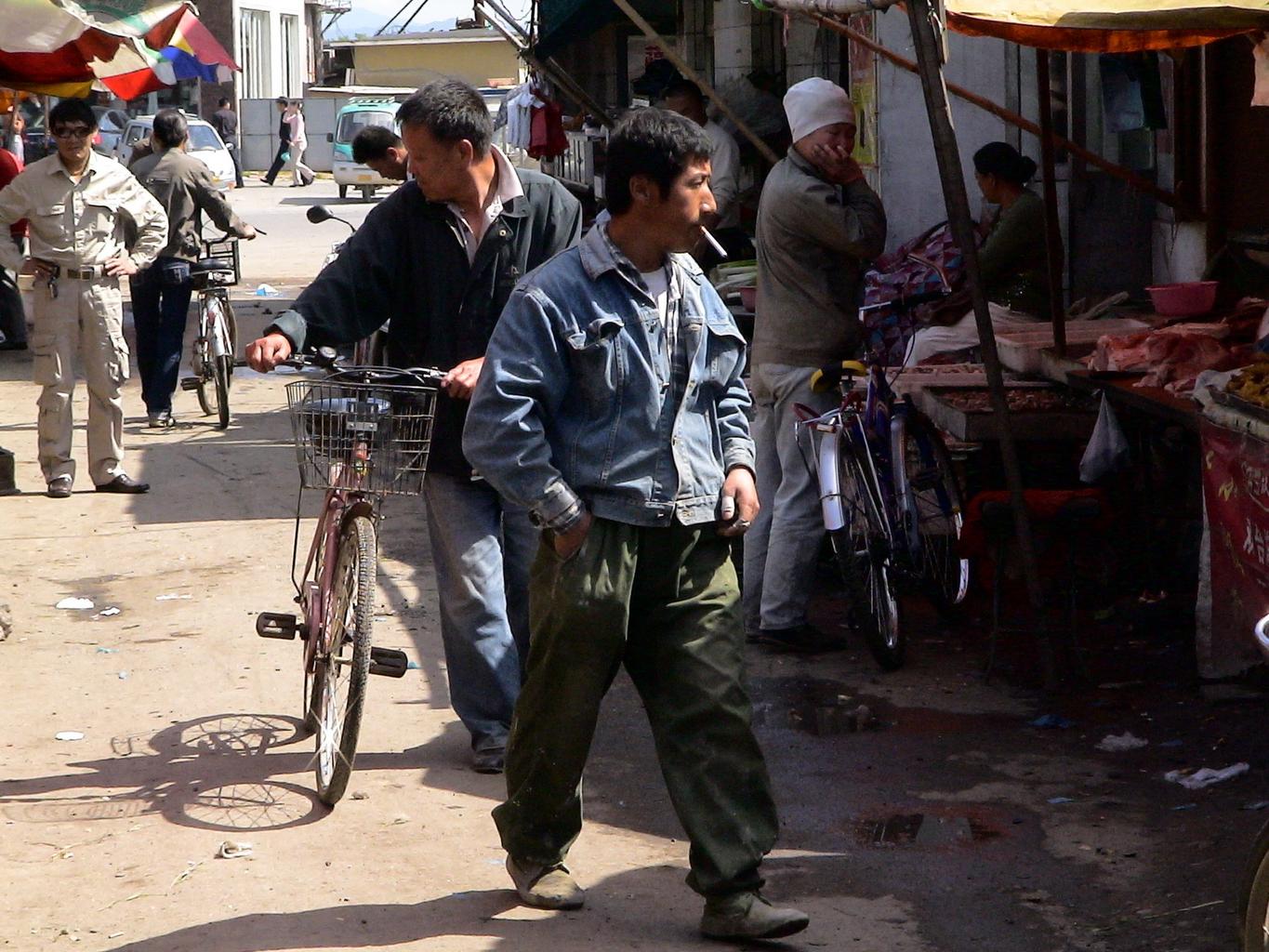Abstract
The proportion of rural population to the total population varies widely between countries and regions, with some countries, such as Liechtenstein, showing particularly high proportions. Liechtenstein’s rural population is expected to reach 79.3% in 2023, which is closely related to its small land area. In many developed and urbanized countries, the proportion of rural population is declining and migration to urban areas is increasing. On the other hand, countries like Liechtenstein tend to maintain large rural areas and place importance on the natural environment and traditional ways of life. This high rural population ratio may be the result of land use efficiency and policies aimed at maintaining regional identity. Life in rural areas is more stable and more environmentally conscious than in urban areas, so in countries with a high rural population, these characteristics play an important role in society.
Rural population (percentage of total population)
Looking at data from 1960 to 2050, the change in rural population (as a percentage of total population) clearly shows the progress of urbanization. In 1960, Burundi’s rural population ratio was very high at 97.9%, but today it has fallen to 73.6%. This change reflects the country’s economic development and increasing urbanization. In countries with a high rural population, such as Burundi, agriculture was once the main source of livelihood, but with industrialization and urban development, more people are migrating to urban areas. Overall, the proportion of the rural population has declined between the 1960s and the present, and this trend is evident in many countries. Urbanization has shifted economic opportunities and infrastructure concentrations to urban areas, accelerating population migration from rural to urban areas. This trend is also evident in developing countries, where improving living conditions in cities are driving a decline in rural population. This trend is expected to continue in the future, and the population share of rural areas may decline further.


The maximum is 97.9%[1960] of Burundi, and the current value is about 73.6%
Rural population (percentage of total population) (worldwide)
Between 1960 and 2050, the rural population (as a percentage of the total population) shows notable changes, with the case of Burundi being a prime example. In 1960, Burundi’s rural population ratio was 97.9%, meaning that almost the entire population lived in rural areas; today, this ratio has fallen to 73.6%. This change reflects increasing urbanization and economic development. Many developing countries, including Burundi, are undergoing a shift from an agricultural economy to industrialization and urbanization, which has accelerated population migration to urban areas. The decline in the rural population ratio from the 1960s to the present is due to increased migration to cities in search of better education, health care and economic opportunities. Improved living conditions and infrastructure development in cities encouraged population migration from rural areas. This trend is expected to continue in the future, with the rural population ratio predicted to decline further and the urban population ratio predicted to increase.


The maximum is 97.9%[1960] of Burundi, and the current value is about 73.6%
Rural population (percentage of total population) (Worldwide, latest year)
Looking at the data for rural population (as a percentage of total population) for 2050, we can see that Liechtenstein has the highest proportion at 79.3%, which is significantly higher than the average of 28.9% and the total of 5.67k%. Liechtenstein’s high proportion of rural population is due to its small land area and the emphasis on traditional agriculture and nature conservation. In the context of growing metropolitan areas, such high rural population ratios reflect the particular social and economic conditions of the region. Overall, the rural population ratio varies greatly by region, generally being lower in developed and urbanized countries, while it tends to be relatively high in developing countries and countries where agriculture is the primary industry. The average value of 28.9% indicates an overall increase in urbanization, indicating that urban expansion is leading to a decline in the rural population ratio. This has resulted in a widening gap between urban and rural populations, a trend that is expected to continue in the future.


The maximum is 79.3% of Liechtenstein, the average is 29%, and the total is 5.63k%
Rural population (percentage of total population) (region, latest year)
Data for 2050 shows that South Asia will have the highest rural population (as a percentage of total population) at 47.6%, significantly higher than the average of 29.6% and the total of 445%. In South Asia, many people still work in agriculture, indicating that rural life is widespread. This is because the region’s economic structure and lifestyle are relatively behind the wave of urbanization. With the overall average being 29.6%, the rural population ratio is generally low in countries undergoing rapid urbanization, and conversely, high in regions where agriculture is the main industry. This trend reflects the decline in rural populations in developed countries and economically developed cities, as well as increased rural-to-urban migration. The total figure of 445% combines data from multiple regions and countries, allowing for regional variations. In areas with a high rural population ratio, migration to urban areas is increasing, while in areas highly dependent on agriculture, the ratio remains relatively high. In the future, as urbanization and economic development progress, the rural population ratio will continue to show different trends from region to region.


The maximum is 47.6% of South Asia, the average is 29.6%, and the total is 445%



Comments